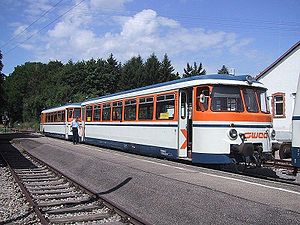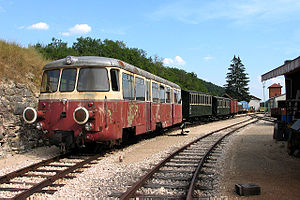MAN rail bus
| MAN rail bus | |
|---|---|
|
MAN rail bus of the SWEG in Neckarbischofsheim Stadt station
|
|
| Number: | 38 |
| Manufacturer: | MAN |
| Year of construction (s): | 1955-1969 |
| Axis formula : | A'A '/ A'1' |
| Gauge : | 1435 mm (standard gauge) |
| Length over buffers: | 16,200 mm |
| Length: | 15,200 mm |
| Height: | 3,450 mm |
| Width: | 2,950 mm |
| Total wheelbase: | 9,000 mm |
| Smallest bef. Radius: | 150 m |
| Empty mass: | 20.5 t (with two drive systems) / 16.8 t (with one drive system) / 13.9 t (trailer) / 14.0 t (control car) / 10.1 t (control car in lightweight construction) |
| Top speed: | 70 km / h (type Hameln) / 80 km / h (type MEG) / 90 km / h (type Braunlage) |
| Installed capacity: | 112 kW (150 PS) / 134 kW (180 PS) / 149 kW (200 PS) |
| Driving wheel diameter: | 900 mm |
| Motor type: | D 1246 M2T1U / D 1546 MTU2S / D2156 HM1US |
| Rated speed: | 2000 rpm |
| Power transmission: | Voith Diwabus 200 D or ZF Friedrichshafen 3 HM 60 |
| Tank capacity: | 300 l |
| Coupling type: | Screw coupling |
| Seats: | Railcar: 66–70 / sidecar: 74 / control car: 50 |
| Standing room: | Railcar: 45 / sidecar: 45 / control car: 25 |
| Floor height: | 1,100 mm |
The MAN rail bus is a rail bus that was developed and manufactured by MAN . The development of the railcar began in the 1950s, since 1955 it has been used by non-federal railways .
history
At the beginning of the 1950s, the Deutsche Bundesbahn needed new, inexpensive railcars for their branch lines, which were supposed to replace the expensive steam trains there. As a result of the developments, the Uerdingen rail bus was created , which had a total of 1492 vehicles. MAN was also involved in the production of the railcars known as the DB series VT 95 . But many smaller private railways with their own route networks were also looking for alternatives to their locomotive-hauled trains. Several manufacturers offered models for this customer group, including MAN the MAN rail bus with two single-axle bogies.
The first order for the MAN railbus came from the Deutsche Eisenbahn-Betriebs-Gesellschaft (DEBG) for the Vorwohle-Emmerthaler Eisenbahn-Gesellschaft (VEE); There were further orders from the Osterwieck-Wasserlebener Eisenbahn (OWE), the Alsternordbahn (ANB) and the Mittelbadische Eisenbahnen (MEG).
The following companies purchased brand-new MAN rail buses:
- Vorwohle-Emmerthaler Eisenbahn (VEE): 1
- Osterwieck-Wasserleben Railway (OWE): 2
- Alsternordbahn (ANB): 3
- Railway Altona-Kaltenkirchen-Neumünster (AKN): 10
- Central Baden Railways (MEG): 5
- Uetersener Eisenbahn (UeE): 2
- Peine-Ilseder Railway (PIE): 5
- Schleswig circular path : 1
- Elmshorn-Barmstedt-Oldesloer Eisenbahn (EBOE): 1
- Hohenzollerische Landesbahn (HzL): 4
- Südharz-Eisenbahn-Gesellschaft (SHE): 1
- Cologne-Mülheim – Leverkusen railway : 2
- Southwest German Railway Company (SWEG): 2
Companies that acquired used cars:
- Württemberg Railway Company (WEG)
- Württemberg branch lines (WN / Wüna)
- Vorwohle-Emmerthaler Verkehrsbetriebe (VEV)
- Altona-Kaltenkirchen-Neumünster Railway (AKN)
- Kahlgrund Verkehrs-GmbH (KVG)
- Hamburg port railway
- Lower Rhine transport company
- Rhine brown
- Karsdorf Railway Company (KEG)
- Rhine-Sieg Railway (RSE)
- WB Wiehltalbahn GmbH (WB)
Companies that use rented cars:
- German Railways (DB)
- German Regional Railway (DRE)
A total of 60 vehicles were built, 39 of which were powered, 18 as control cars and three as sidecars .
Technical
Versions
The railcar was available in single-engine and twin-engine versions. Most of the railcars were delivered with two engines. MAN six-cylinder diesel engines from our own production were used. 1955 to 1959 it was the D 1246 M2T1U with 110 kW (150 PS), 1960 to 1966 the D 1546 MTU2S with 132 kW (180 PS) and 1966 to 1969 the D 2156 HM1US with 147 kW (200 PS).
Drive, power transmission
Unlike the Uerdinger rail buses, the six-speed gearbox was fitted with a manually switching, some of the MAN railcars possessed a fluid transmission of the companies Voith and ZF Friedrichshafen . In these vehicles, therefore, no gear selector lever was required in the dashboard. An option to switch to “mountain gear” made it possible to use the braking power of the engine on steep slopes.
MAN rail buses were also equipped with a ZF 3 HM 60 (Hydromedia transmission). Like the Uerdinger, these had manually shiftable gears. The six gears in the Uerdinger are shifted electromagnetically, while the three gears in the MAN are shifted electro-hydraulically. The power transmission takes place in each case by multi-plate clutches.
Due to the hydraulic engagement of the gears, the Hydromedia transmission reacts more brutally when changing gears. Not optimal coordination of the switching points with the engine speed lead to clearly noticeable jerks, the Uerdinger reacts more gently.
The Uerdinger has a fluid coupling between the engine and the gearbox (without a stator), power can be transmitted in both directions, so the engine brake can be used. The MAN (Hydromedia) has a converter there.
landing gear
What was special about this rail bus was the single-axle drawbar frame. A larger wheelbase and thus a greater overall length than the Uerdingen rail bus was possible. There was also a greater smoothness. The axle was mounted in a frame with roller axle bearings. This frame had its pivot point in the direction of the center of the car, opposite a reset device. Rubber balls were embedded in the frame on which the car body was supported. From 1960 there was also air suspension.
Car body
The car body was constructed using a self-supporting lightweight steel construction, only the two control cars of the Bayerbahn Cologne-Mülheim-Leverkusen were constructed using a self-supporting foam filling construction. This enabled a weight saving of around 50 percent to be achieved. On each side of the car there were two three-wing folding doors (rarely four-winged) that were operated by hand. The railcars of the AKN, Alsternordbahn and Uetersener Eisenbahn had electro-pneumatic locking devices. The interior design was different. The driver's cabs were partitioned off on some vehicles and not on others. There were seated cars and those with a luggage compartment. Some railcars also had a toilet. The first copies (VEE and OWE) had radiator slots in the front. The Hohenzollerische Landesbahn had railcars with transitions in the front. The AKN railcars had a roll-up display in the middle front window . Most of the railcars were painted in the dark red customary on the Deutsche Bundesbahn. At MEG they wore the corporate colors cream / green, at HzL cream / red. The railcars of the Uetersener Eisenbahn were cream / blue, the Bayerbahn cars were blue.
Seven windows were arranged on the side, the seat divider was 2 + 3, so that the basic version had 70 seats in mostly two passenger compartments (three plus four windows). For the toilet, four seats were omitted, also in a small luggage compartment, and correspondingly more in a larger luggage compartment.
Calls
The railcars were mainly used for passenger traffic, but some railways also used their railcars as towing cars in front of freight trains, such as the SWEG, the WEG or the WN. Mostly it was one or two-part units, but three-part units were also possible. The last scheduled operations in passenger traffic took place by the end of July 2009 at SWEG on the Schwarzbach and Krebsbachtalbahn . The association “Schwäbische Alb-Bahn e. V. “uses MAN rail buses on the Swabian Alb Railway (Münsingen – Schelklingen).
Meter-gauge railcars
| MAN rail bus (meter gauge) different dimensions |
|
|---|---|
|
T 37 of the Härtsfeld Museum Railway in Neresheim
|
|
| Number: | 1 |
| Axis formula : | B'B ' |
| Gauge : | 1000 mm ( meter gauge ) |
| Trunnion Distance: | 10,000 mm |
| Bogie axle base: | 2,000 mm |
| Total wheelbase: | 12,000 mm |
| Empty mass: | 24 t |
| Top speed: | 40 km / h |
| Installed capacity: | 134 kW (180 PS) |
| Driving wheel diameter: | 800 mm |
| Motor type: | D 1546 MTU2S |
| Power transmission: | Voith Diwabus 200 D |
| Coupling type: | Central buffer coupling |
| Seats: | 70 |
The railcar for the Südharz-Eisenbahn-Gesellschaft (SHE) was the only MAN rail bus to be delivered in meter gauge and received two two-axle bogies instead of the single-axle bogies of the standard gauge versions. The external dimensions were the same as the standard gauge version, but the doors were shifted by two windows towards the center due to the bogies , so that three compartments were available.
After the closure of the Walkenried – Braunlage / Tanne narrow-gauge railway in 1963, it went to Württembergische Nebenbahnen AG, which modified it for its purposes and used it on the Härtsfeldbahn . For use in Rollbock traffic, it was also given standard-gauge buffers so that it could be used as a tow car. In addition, the engines were replaced by 156 kW engines from Büssing (U 11 D). Today it is at the Härtsfeld Museum Railway, where it is currently being refurbished.
Whereabouts
The railcars VT 27 and VT 28 of the SWEG have been preserved by the Eisenbahnfreunde Breisgau.
gallery
RSE MAN rail bus on the Bonn-Beuel – Hangelar railway line
The former VT 2.17 of the AKN on the Buckower Kleinbahn
literature
- Stephan Kuchinke: MAN rail bus. transpress Verlag, Stuttgart 2002, ISBN 3-613-71168-0 .
- Jens Merte: MAN Maschinenfabrik Augsburg Nürnberg AG (delivery list). January 1, 2008, without ISBN.








